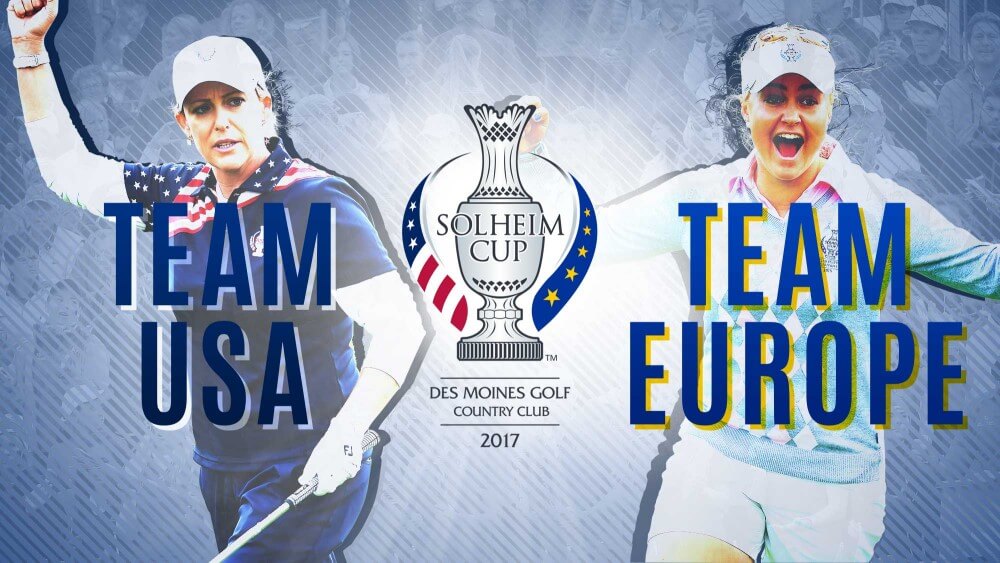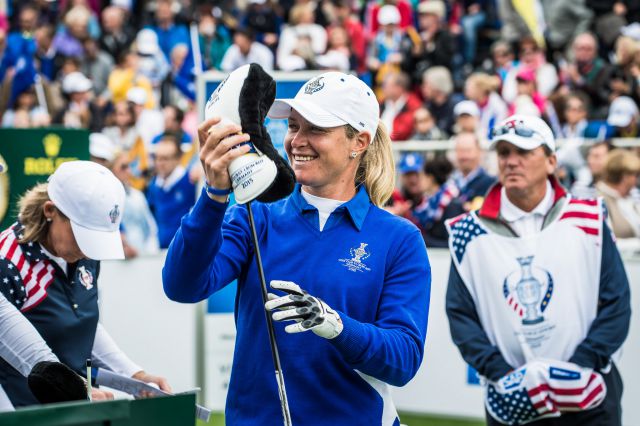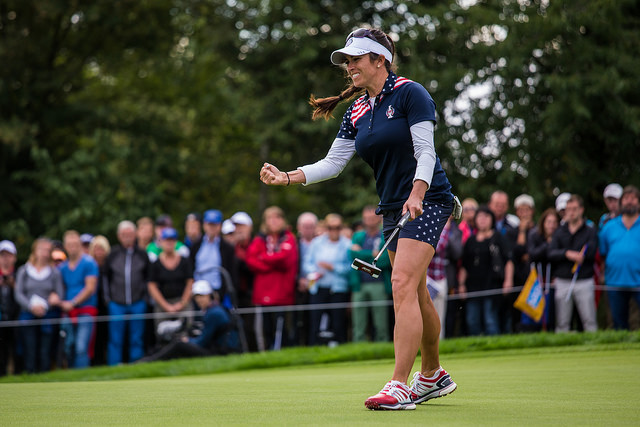Most golfers and fans of the game think of golf as an individual sport. That’s because most golf tournaments we watch on TV and play use stroke or medal play. In that format, the player who takes the fewest strokes wins the tournament.
But beginning Friday, August 18th through Sunday, August 20th, golf fans have a unique opportunity to watch 24 top women golfers compete in the 2017 Solheim Cup using the match-play format. NBC-TV is providing extensive coverage, including streaming.
The Women’s Solheim Cup consists of a team of 12 golfers from Team Europe playing against 12 players from Team USA. Over three consecutive days, 28 matches are played. Juli Inkster is the Captain of Team USA and Annika Sorenstam is the Captain of Team Europe. The event will be held at the in Des Moines Golf and Country Club in Des Moines, Iowa on a course designed by Pete Dye.

Friday and Saturday matches are played in Twosomes vs. Twosomes but with different formats. Friday and Saturday morning formats are “Foursome” (also called “Alternate Shot” format). Friday and Saturday afternoon formats are “Fourballs” (also called “Better Ball”). Sunday matches are head-to-head individual match play.
The winning team of each match receives either one point if they win or, one-half point if the match is tied. If Team USA receives 14 points, it retains the Cup as the 2015 winner. Team Europe takes the Cup back if it receives 14-1/2 points. See my previous article about the tournament basics at womensgolf.com/solheim-cup-2017.
The Solheim Cup is the ultimate in match play. And here’s the key element in the Solheim Cup. Each Captain selects what players play in what matches – without knowing who they will be playing against. The Captains each submit the list of players (in order of the matches – first match, second match, etc.) the night before the matches will be played. The Captains must have a strategy about what players they are sending out and for what formats. Sometimes, a player may be asked to play in both the morning and afternoon matches on Friday or Saturday.
Did the Captains select the right players and pairings?

It will not be until Thursday evening when Juli Inkster, Captain of Team USA and Annika Sorenstam, Captain of Team Europe announce which of their players will play in the Friday matches.
In Friday’s morning format, two players from each Team compete against two players from the other Team – each Team member hitting alternate shots until the ball drops in the cup. Some questions to think about: Did the Captain pick players who will be able to deal with a partner who plays a poor shot? Did the Captain select their best players to go out first to build up momentum? Did the Captain select players with different skills: A player with a strong short game paired with a player who hits a long tee shot? Was a rookie player paired with a veteran player? Was an aggressive player paired with a more conservative player? Complicating the Captain’s decisions is that they do not have a clue as to how the other Captain is lining up her players.
The Captain will face similar choices when she chooses who plays with whom in the Foursomes format (also often called “Better Ball”). In that format, each player plays her own ball from tee to green. And the score of the player with the “best” score wins the point for her team. How do the partners from each Team support each other during this format? Did the Captain make the right decision?
All twelve players must play individual matches on Sunday, but who their opponents will be is not disclosed until the night before. For that final day list, will the Captain put the strongest player out first? Remember each Captain will not know the other Captain’s list beforehand.
You can be sure that the Team Captains have thought a lot about their lineup. At the extremes are Captains who think that the team spirit is more important than the pairings themselves. At the other extreme are the Captains who study data and each player’s strength and weaknesses thoroughly in selecting the pairings. Let’s see how these Solheim Captains make their choices.
Do the players demonstrate a team attitude?

Here’s what I would watch for in the Alternate Shot format? Do the players confer about their shots? For example, on a Par- 3, does Player A who tees off (and hopefully can land it on the green) confer with her teammate Player B about what part of the green is the ideal landing place since she will have to putt that ball. On a par-5, where player A has hit a good drive, and Player B now has a choice: To go for the green or lay it up and leave Player A with the chip shot; do they confer?
In the better ball format, even though each player is playing her own ball, do the players welcome advice from their teammate? If a player is not conferring with her partner, it is a clue that the Captain may not have done her job in developing a team spirit.
Will you ever hear “I’m sorry?”

Here is one scenario you will see. Player A has put the ball four feet from the hole. Her partner Player B misses the putt. Does Player B say “I’m sorry” to player A? Answer: Probably not. In fact, Player A’s role is to tell Player B that she made a good try and do everything she can to avoid placing any blame on her partner. That is what team play is all about. If it looks like players are thinking more like individual golf stars rather than members of a team that will be a bad sign and reflect on the Captain’s leadership.
Do you know what “Dormie” means?

You will hear announcers use it many times during this tournament and it is a term unique to match play. It means that the leading golfer’s margin is the same as the number of holes remaining. At the end of the fifteenth hole, for example, instead of saying “3-up with three holes to play”, an announcer might say that the leader is “dormie” or “dormied.” Lots can happen when a player is dormie: She can tie all the remaining holes and win one-half point She can lose the next hole and be “2 up with 2 holes to go” which adds more pressure on both players. Or, she can win the next hole and the match is over at the end of the 16th hole with a score of “4 up and 2 to go” – or more simply said, “She won 4 – 2.” (The word “dormie” comes from the French “dormir” – to sleep. If a player is dormie and loses, she very well might feel like heading back to her room for a nap.)
Expect the players to be very careful about not incurring any penalties.
The penalties in match play are very different from those used in stroke (or medal) play. In match play, most often the penalty is loss of the hole whether the infraction was on the first shot or the fourth shot. In contrast, in stroke play, the penalty is usually just one or two strokes. Because penalties in match play are so harsh, expect players to be very careful and to call in the rules officials when in doubt. For example, if a player hits a man-made object like a TV tower, expect the players to call in the officials to make sure where the player can take a “free” drop without penalty.

In match play, a team (or an individual player) can concede a putt – or even the entire hole.

So, if you are watching the matches and you see that a player does not hole-out her ball, it is probably because the other team has simply said “that ball is good.” Or in a worst case scenario, where one team has just had trouble, more trouble and even more trouble, for instance hitting from rough into a bunker, missed bunker shot, then into rough – while the other team is sitting pretty with a one foot putt, it is possible the team in trouble could just concede the hole.
Use the internet to learn more about the players and the matches and set your TV to “record.”
The coordinators of this Solheim Cup have done an outstanding job of providing information. Go to solheimcup.com, lpga.com, and ladieseuropeantour.com. Here is the link for TV coverage. Of course, check back here on womensgolf.com where more articles about the Solheim Cup will be posted.
I am very excited to be a media representative for womensgolf.com on site at the Des Moines Golf and Country Club. I even got a head start by interviewing, John Miller, the LPGA Agronomist about his work along with the Club’s Golf Superintendent over the past two years to get the Des Moines Golf and Country Club in perfect tournament conditions. See the interview here.






